马里亚纳海沟是目前所知世界上最深的海沟,位于菲律宾东北、马里亚纳群岛附近的西太平洋。马里亚纳俯冲带具有典型的“沟-弧-盆”体系,是由太平洋板块向西俯冲到菲律宾海板块之下形成的洋-洋俯冲带[1-3],马里亚纳海沟全长2 550 km,平均宽度为70 km,目前已探测到最深处达到11 034 m,被称为“挑战者深渊”[4-6],“挑战者深渊”位于马里亚纳海沟的南端,且东西方向延伸[2]。马里亚纳海沟5 000 m以上区域坡度较为平缓,在5 000 m以下区域存在陡坡[7]。其6 000 m以下几乎完全由海沟组成,是地球上研究最少的水生生物圈。海沟周围具有地形陡峭、静水压力高、温度低的特点,周期性地受到由浑浊流和地震活动与陡峭地形相结合引起的滑坡[8]。海沟环境与深海海洋的区别在于它们的静水压升高和它们的水文地形隔离性质,而其他的物理和化学条件,如温度、盐度、溶解氧和营养盐等与深海海洋的条件基本一致[4, 8]。
N、P、Si是海洋生物生长所必须的最重要元素,也是海洋初级生产过程和食物链的基础,其在海水中的含量高低会影响海洋生物生产力与生态系统的结构[9-10]。海沟中营养盐的主要来源于上层海水的垂直下沉、动物尸体的沉降分解以及地震等构造活动。此外,由于海沟的特殊构造,通过斜坡的横向输送也会使营养盐到达沟渠地面(也被称为“漏斗效应”)[11],颗粒物沉降和埋藏是营养盐的主要迁出途径[4, 12]。Takuro Nunoura等的研究表明马里亚纳海沟磷酸盐(PO4-P)、硝酸盐(NO3-N)及亚硝酸盐(NO2-N)浓度在海沟深度和深海平原之间是相似的[4, 13]。在Riley等在调查中发现,深海盆地和海沟水域中,硅酸盐(SiO3-S)含量的垂直分布含量随深度的增加而增加,通常在颗粒硅溶解的主要水层出现最大值[14]。马里亚纳海沟区域深层水中主要包括两个水团:下环极深层水(LCPW)和北太平洋深层水(NPDW)[15]。具有高溶解氧、高盐特征[16]的LCPW,向新西兰东北方向流动,一直延伸到中太平洋盆地。LCPW的一些分支经过赤道和东马里亚纳盆地进入西北太平洋和西马里亚纳盆地[15, 17]。NPDW自东北太平洋流入[18],从东马里亚纳盆地东南方向延伸到了东马里亚纳盆地西南方向,水团的高硅核心在2 500~3 500 m,具有高硅的水系特征[15]。
深海水团运动、生物活动以及地震等构造活动可能会影响海沟内营养盐的分布变化,为进一步研究马里亚纳海沟中温度、盐度、溶解氧(DO)、pH以及营养盐的分布特征,本文采集了马里亚纳海沟“挑战者深渊”从表层到深层(0~8 727 m)的水样,并对其pH、DO、和不同形态的营养盐进行了分析。
1 采样与方法 1.1 研究站位2015年12月,在马里亚纳海沟“挑战者深渊”(142°18.105′E,11°22.569′N)分6个水层采集样品,采样水深分别为0,1 000,1 759,3 699,5 367,7 200和8 727 m,具体见图 1。
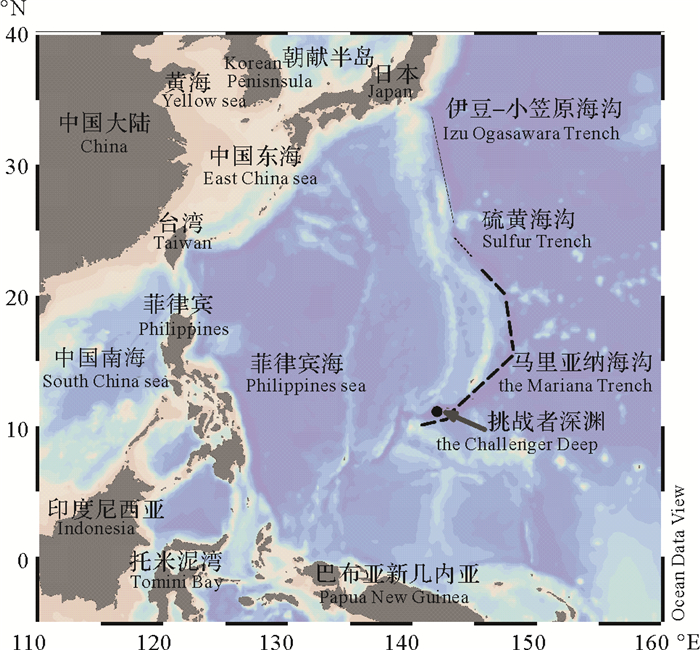
|
(图中粗虚线代表马里亚纳海沟区域,黑色圆点代表“挑战者深渊”采样位置。The thick dash line represents the Mariana trench, and the black dots represent the sampling location of the challenge deep.) 图 1 “挑战者深渊”采样站位示意图 Fig. 1 Sampling stations in the Challenge Deep |
海水温度和盐度在现场由CTD测定,DO采用碘量法测定,pH采用pH计法测定。采集的海水样品经0.45 μm醋酸纤维膜(经1‰的盐酸浸泡24 h后用Milli-Q水冲洗至中性)过滤。取部分滤液现场测定DIN和DIP[19]。其中NH4-N利用次溴酸钠氧化法测定,NO3-N为Cd-Cu还原法,NO2-N为α -萘乙二胺分光光度法,PO4-P为磷钼蓝法,SiO3-Si为硅钼蓝法;另一部分滤液直接装于聚乙烯瓶(预先于HCl溶液中浸泡24 h,后用蒸馏水及Milli-Q水洗至中性),-20 ℃条件下冷冻保存,回岸上实验室分析DTN和DTP。DTN和DTP的测定采用碱性过硫酸钾氧化法[20]进行。
溶解氧、溶解态无机营养盐采用国家海洋局第二海洋研究所生产的碘酸钾标准溶液和营养盐标准溶液作为外标质控样,测定结果符合要求。各要素方法检出限分别为:溶解氧为0.02 mg/L,硝酸盐为0.03 μmol·L-1,亚硝酸盐为0.02 μmol·L-1,氨氮为0.03 μmol·L-1,磷酸盐为0.02 μmol·L-1,硅酸盐为0.45 μmol·L-1。溶解有机氮(DON)和溶解有机磷(DOP)则根据DTN、DIN和DTP、DIP的差值计算得出:DON=DTN-DIN;DOP=DTP-DIP。
2 结果与讨论 2.1 温度、盐度的分布特征从图 2可以看出,随着深度增加,马里亚纳海沟“挑战者深渊”的海水温度从表层的28.12 ℃迅速降低至2 000 m左右的2.39 ℃,在4 000~7 200 m以深,温度大约在1.60 ℃左右,而到8 727 m温度增至2.0 ℃,大约升高0.4 ℃,这是因为沟槽内的底层水温随着静水压力(即深度)的增加而变暖,在压力增大的情况下,水分子会产生压缩性效应,会放出热量[5, 21]。盐度变化曲线显示在表层水体中盐度为34.4,表层以下,盐度随着深度的增加而逐渐增加,在3 000 m左右盐度增大,这是因为在3 000~5 000 m左右LCPW的存在[22-23],高盐水团的输入导致了盐度的迅速增加,4 000 m以下,盐度基本维持在34.7左右。
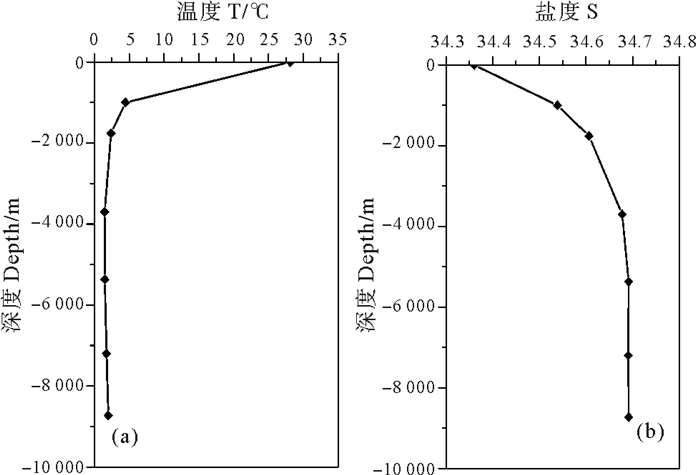
|
图 2 马里亚纳海沟“挑战者深渊”温度(a)和盐度(b)的垂直分布特征 Fig. 2 Vertical distribution characteristics of temperature (a) and salinity (b) in the Challenge Deep of the Mariana trench |
马里亚纳海沟“挑战者深渊”处pH值的垂直分布见图 3,表层水体出现pH极大值为8.30,这是由于生物光合作用会迁出水中的CO2,导致pH值的增加[24]。随深度的增加,pH值降低,至1 000 m左右出现7.89的极小值,该区间pH降低的主要原因是由于生源碎屑的氧化分解会增加水体中的CO2,导致pH值出现极小值[25]。自极小值层以深,pH值略有增加,大约维持在7.90左右,这主要是CaCO3的溶解降低水体中CO2,造成的pH值增加[24]。
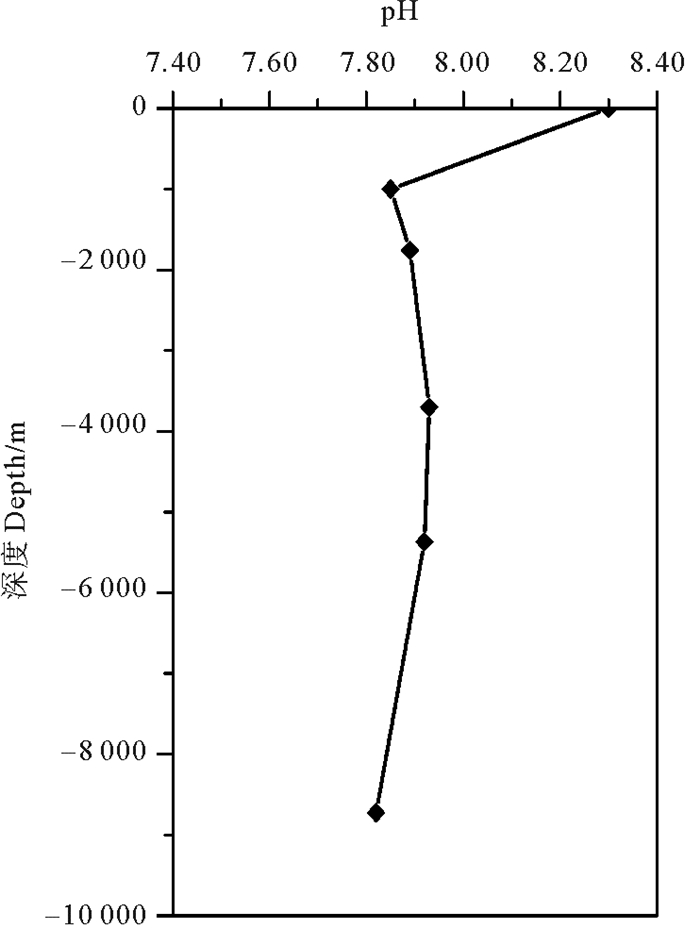
|
图 3 马里亚纳海沟“挑战者深渊”pH的垂直分布特征 Fig. 3 Vertical distribution characteristics of pH in the Challenge Deep of the Mariana trench |
马里亚纳海沟的DO的分布特征如图 4中所示。在表层有DO最大值6.57 mg·L-1,在1 000 m处出现溶解氧的极小值2.77 mg·L-1,这是由于有机物的氧化分解作用和海洋生物的呼吸作用,溶解氧浓度随深度增加逐渐降低[26]。在极小值以深,DO的含量逐渐增加,在5 367 m处出现极大值5.79 mg·L-1,这可能是高纬度富氧海水下环极深层水(LCPW)下沉不断补充的结果[26-27]。在马里亚纳海沟3 000~5 000 m以深有LCPW的存在[22-23],LCPW来自南极底层水(AABW),具有低温、高溶解氧、高盐的特征。随着洋流的输送,高溶解氧的海水向马里亚纳海沟中输送[28]。DO的含量在极大值以深随深度的增加略有降低,但在8 727 m的海洋超深渊层仍有较高的溶解氧值,这可能是富氧海水向下扩散所导致的[13, 29-30]。马里亚纳海沟DO的垂直分布与Taejin Kim等在北太平洋区域的观测结果[31]较为相似。
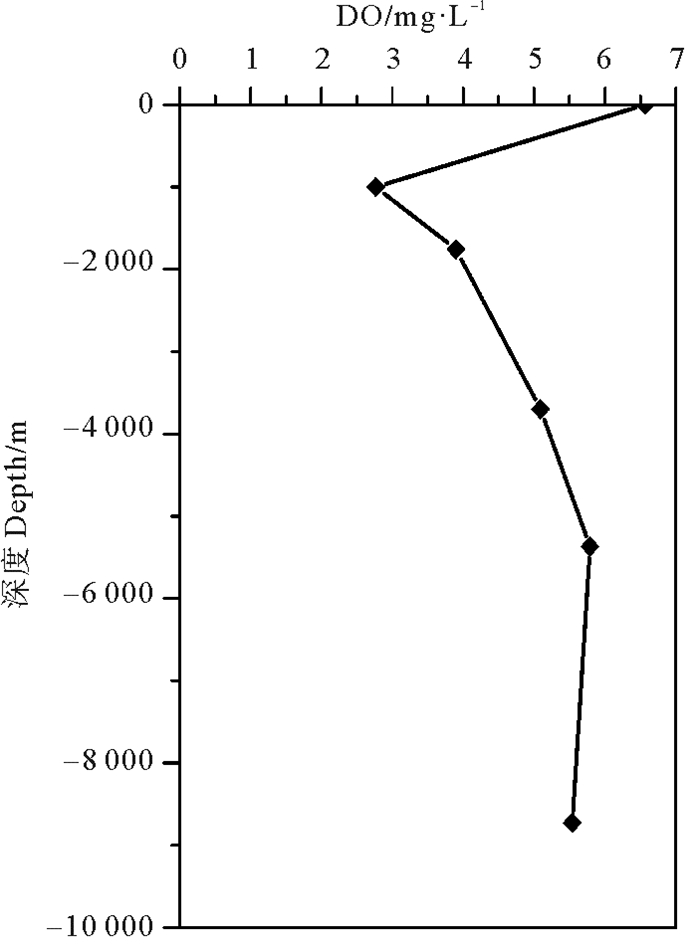
|
图 4 马里亚纳海沟“挑战者深渊”溶解氧的垂直分布特征 Fig. 4 Vertical distribution characteristics of dissolved oxygen in the Challenge Deep of the Mariana trench |
马里亚纳海沟“挑战者深渊”各形态氮的垂直分布如图 5所示,NO3-N在表层水体中浓度很低,在1 000 m处出现第一个峰值,其浓度达到41.47 μmol·L-1。随着深度的增加,浓度逐渐降低,在3 699 m处达到27.73 μmol·L-1,在5 367 m出现第二个峰值(43.10 μmol·L-1)。5 367 m以深,NO3-N浓度略有降低。马里亚纳海沟表层水体中NO3-N浓度几乎接近分析零值,这是在表层中浮游植物生长消耗所致[32]。随着深度的增加,由于生物碎屑的氧化分解使得NO3-N的浓度在1 000 m达到最大值,而在5 000 m左右出现第二个极大值可能是由于马里亚纳海沟特殊的构造,在其陡坡处由于重力驱动产生了下坡输沙[4, 6],导致了斜坡上有机物的积累,当有机物发生降解时就引起了无机态营养盐的变化[33]。
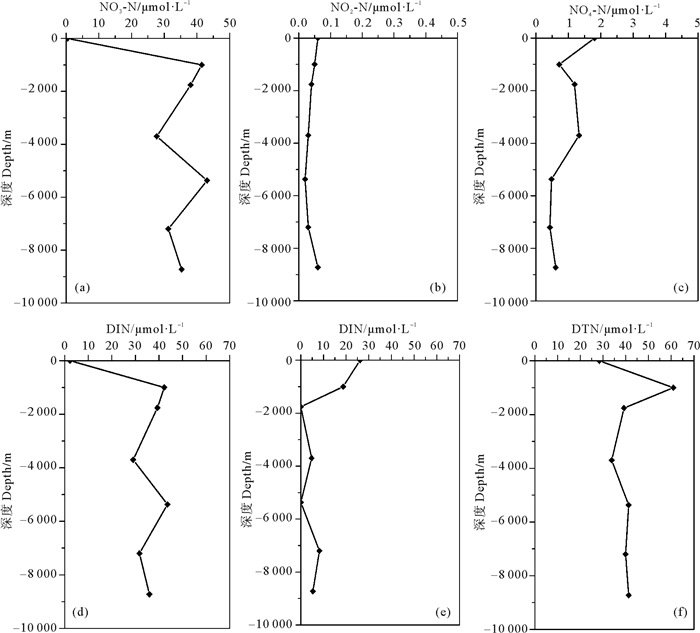
|
图 5 马里亚纳海沟“挑战者深渊”溶解态氮的垂直分布特征 Fig. 5 Vertical distribution characteristics of all forms of nitrogen in the Challenge Deep of the Mariana trench |
“挑战者深渊”NO2-N整体浓度较低且随深度变化不大,最大浓度小于0.1 μmol·L-1。NH4-N在表层水体中的含量为1.81 μmol·L-1,随深度增加逐渐降低,1 000 m处达到极小值(0.72 μmol·L-1),在极小值以深浓度逐渐增加,在3 699 m处达到极大值。在极大值以深,NH4-N浓度迅速降低,并维持在0.50 μmol·L-1左右,这可能是由于在海沟8 000 m左右深处有较高溶解氧值,硝化作用仍旧维持在较高水平,导致NH4-N浓度降低。
DIN在马里亚纳海沟“挑战者深渊”的分布与NO3-N基本一致,且NO3-N含量占DIN约为98%。在表层水体中,DON的浓度较高,可能是微生物的同化作用导致DON的积累。随着深度的增加逐渐降低,在1 759、5 367 m处达到分析零值,在5 367 m以深,DON浓度略有增加。DTN在1 000 m达到极大值,在极大值以深浓度降低,并维持在39 μmol·L-1左右。在表层中,DON是DTN的主要组成成分,随着深度的增加,DIN逐渐占据主导地位。各形态的溶解氮的浓度变化趋势如图 5所示。
2.4.2 溶解态磷PO4-P在表层水体中含量较低,随深度的增加PO4-P含量迅速增加,在1 000 m处达到极大值(2.84 μmol·L-1)。在表层水体中,生物活动的吸收导致PO4-P含量很低[34]。在1 000 m左右出现极大值是因为含磷颗粒在重力的作用下沉一直带到1 000 m以深的海水中,由于细菌的分解氧化,PO4-P又被释放回海水中[35-37],导致PO4-P的浓度随着深度的增加迅速增加。在1 000 m以深,PO4-P的浓度略有降低,由于垂直涡动扩散,使不同水层的PO4-P浓度趋于均等,PO4-P随深度的增加变化很小[38],基本维持在2.40 μmol·L-1左右。PO4-P的垂直分布与Takuro Nunoura等在“挑战者深渊”处的观测结果较为相似[6]。DTP的垂直分布与PO4-P基本一致。DOP在表层水体中的浓度相对较高,是DTP的主要组成成分,在表层以深DOP的浓度接近分析零值,DTP主要受DIP控制,这表明表层以深存在DOP的降解和DIP的再生转化(见图 6)。
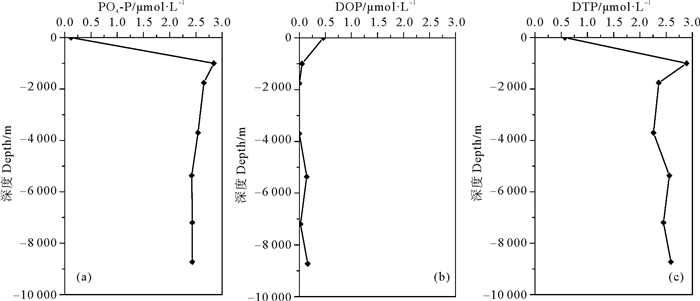
|
图 6 马里亚纳海沟“挑战者深渊”各溶解态磷的垂直分布特征 Fig. 6 Vertical distribution characteristics of dissolved phosphate in the Challenge Deep of the Mariana trench |
马里亚纳海沟“挑战者深渊”表层水体中,SiO3-Si的浓度相对较低。随着深度的增加,海水中的SiO3-Si浓度逐渐增加,但与NO3-N、PO4-P不同的是,SiO3-Si并没有在1 000 m左右出现极大值,而是在3 699 m处出现最大值(161.65 μmol·L-1),在最大值以深,SiO3-Si的浓度略有降低,但基本稳定在150 μmol·L-1左右(见图 7)。
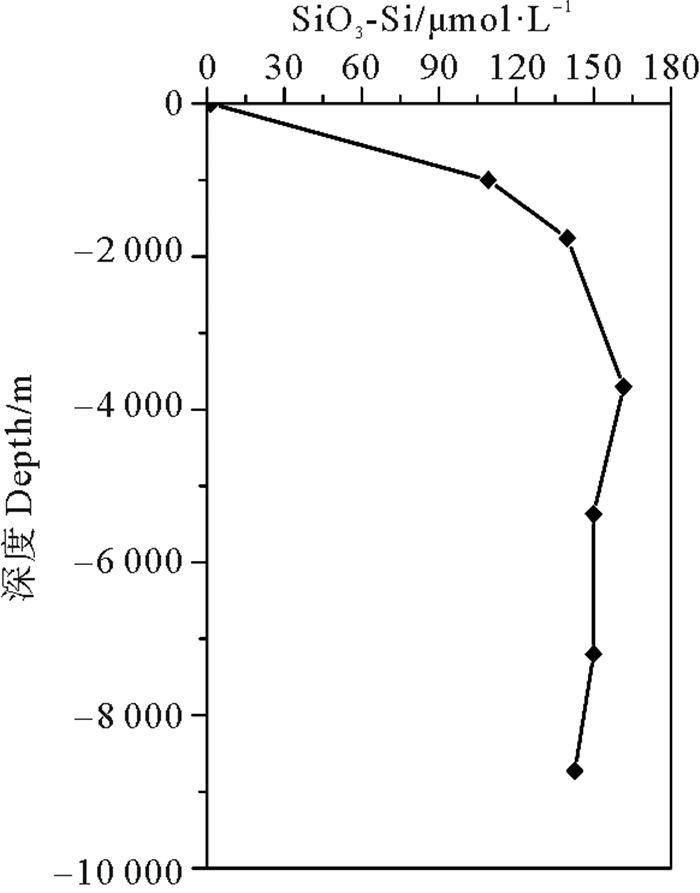
|
图 7 马里亚纳海沟中“挑战者深渊”溶解态硅的垂直分布特征 Fig. 7 Vertical distribution characteristics of silica in the Challenge Deep of the Mariana trench |
“挑战者深渊”SiO3-Si的垂直分布与北太平洋的分布相似[3]。SiO3-Si浓度在3 699 m处达到最大值,这是由于北太平洋深层水(NPDW)的存在[38],在北太平洋3 500 m左右处是高硅NPDW的核心区域,水团的混合使马里亚纳海沟“挑战者深渊”也具备高Si的特征[29-30]。在海沟8 000 m以下的超深渊层,SiO3-Si的浓度高达150 μmol·L-1。这不仅与生物体的下沉溶解有关,而且与底质表层硅酸盐矿物质的直接溶解有关。临近冬季,生物死亡后残体缓慢下沉,随着深层压力增加,有利于颗粒硅的再溶解作用释放出溶解硅[8]。
2.5 营养盐结构的垂直分布特征总体来说,“挑战者深渊”N/P与N/Si呈现相似的变化趋势,与Si/P呈现相反的变化趋势。N/P比在表层较高,比值接近20。表层以下N/P迅速降低,在3 699 m处出现极小值,比值为11左右。之后比值又开始升高,在5 367 m处出现峰值,比值在18左右,随后N/P比值再次降低,出现第二次极小值,在8 737 m以深比值略有上升(见图 8)。
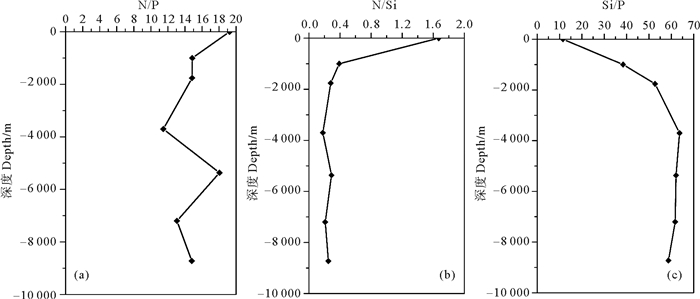
|
图 8 马里亚纳海沟“挑战者深渊”营养盐结构的垂直分布特征 Fig. 8 Vertical distribution characteristics of nutrients structure in the Challenge Deep of the Mariana trench |
N/Si比值在表层出现最大值1.67,随着深度的增加,比值降低,在1 759 m以深比值基本稳定,维持在0.27左右。Si/P比值的变化趋势与N/Si趋势相反,在表层出现最小值11.54,随着深度的增加,比值逐渐增加,在3 699 m处达到极大值,在极大值以深,比值变化不大,比值在59.8左右。一般大洋中的营养盐结构符合Redfield比值(N:Si:P≈16:16:1)[40],但根据先前研究表明,Redfield比值存在不确定性,北太平洋西部深海水域的Redfield比值要低于16[39-41]。
3 结论马里亚纳海沟“挑战者深渊”是目前研究较少的区域,通过对其表层至深层水体中pH、溶解氧以及营养盐的分析,可以得到以下结论:
(1) DO含量表层高,在1 000 m左右出现极小值,1 000 m以深由于富氧水团LCPW的存在DO值增加,在8 000 m左右的超深渊层具有较高的DO值,可能是LCPW向下扩散造成的。
(2) NO3-N、PO4-P含量表层较低,随深度的增加迅速增加,在1 000 m处达到极大值。但NO3-N除在1 000 m处出现第一个峰值外,在4 000 m左右出现第二个峰值,这可能由于重力驱动在海沟4 000 m左右的陡坡处产生了下坡输沙,导致了营养盐的积累。
(3) 在表层水体中,DON、DOP是DTN、DTP的主要存在形式,表层以深,DIN、DIP逐渐占据主导地位。
(4) SiO3-Si含量表层较低,在3 699 m处出现最大值,但在海沟8 000 m左右SiO3-Si浓度仍很高,原因可能是高硅水团NPDW的存在以及冬季生物死亡后颗粒态硅再溶解释放出溶解态硅。
| [1] |
刘鑫, 李三忠, 赵淑娟, 等. 马里亚纳俯冲系统的构造特征[J]. 地学前缘, 2017, 24(4): 329-340. Liu Xin, Li Sanzhong, Zhao Shujuan, et al. Structural characteristics of mariana subduction system[J]. Earth Science Frontiers, 2017, 24(4): 329-340. (  0) 0) |
| [2] |
刘方兰, 杨胜雄, 邓希光, 等. 马里亚纳海沟"挑战者深渊"最深点水深探测[J]. 海洋测绘, 2013, 35(5): 49-52. Liu Fanglan, Yang Shengxiong, Deng Xiguang, et al. Depth detection in the challenger deep of mariana trench[J]. Hydrographic Surveying and Charting, 2013, 35(5): 49-52. (  0) 0) |
| [3] |
刘方兰, 曲佳. 马里亚纳海沟水深探测及"挑战者深渊"海底地形特征[J]. 海洋地质前沿, 2013, 29(4): 7-11. Liu Fanglan, Qu Jia. Seafloor topography and bathymetric survey of the Challenger Deep of Mariana Trench[J]. Marine Geology Frontiers, 2013, 29(4): 7-11. (  0) 0) |
| [4] |
Nunoura T, Takaki Y, Hirai M, et al. Hadal biosphere: Insight into the microbial ecosystem in the deepest ocean on earth[J]. Proc Natl Acad Sci U S A, 2016, 112(11): 1230-1236.
(  0) 0) |
| [5] |
Fujioka K, Okino K, Kanamatsu T, et al. Morphology and origin of the Challenger Deep in the Southern Mariana Trench[J]. Geophysical Research Letters, 2002, 29(10): 1-4.
(  0) 0) |
| [6] |
Carruthers J N, Lawford A L. The deepest oceanic sounding[J]. Nature, 1952, 169(4302): 601-603. DOI:10.1038/169601a0
(  0) 0) |
| [7] |
Jamieson A J, Fujii T, Mayor D J, et al. Hadal trenches: The ecology of the deepest places on Earth[J]. Trends in Ecology & Evolution, 2010, 25(3): 190-197.
(  0) 0) |
| [8] |
范雕, 孟书宇, 邢志斌, 等. 利用重力异常推估海底地形[M]. 国家安全地球物理丛书, 西安: 西安地图出版社, 2017. Fan Diao, Meng Shuyu, Xing Zhibin, et al. Inversion of the Mariana Trench Seabed Terrain Using Gravity Anomaly[M]. Xian: National Security Geophysics Series, 2017. (  0) 0) |
| [9] |
罗延馨, 宋金明. 生源要素的海洋生物地球化学过程研究进展[J]. 海洋科学集刊, 1999(1): 65-78. Luo Yanxin, Song Jingming. Progress in studies on marine biogeochemistry process of biogenic elements[J]. Studia Marine Sinica, 1999(1): 65-78. (  0) 0) |
| [10] |
宋金明, 李鹏程, 詹滨秋. 热带西太平洋定点海域(4°S156°E)营养盐变化规律及降水对海水营养物质影响的研究[J]. 海洋科学集刊, 1997(1): 133-141. Song Jinming, Li Pengcheng, Zhan Binqiu. Variability of nutrients and effect of rainwater on seawater nutrients in the tropical west Pacific[J]. Studia Marine Sinica, 1997(1): 133-141. (  0) 0) |
| [11] |
Liu R, Wang L, Wei Y, et al. The Hadal Biosphere: Recent insights and new directions[J]. Deep Sea Research Part Ⅱ: Topical Studies in Oceanography, 2018, 155: 11-18. DOI:10.1016/j.dsr2.2017.04.015
(  0) 0) |
| [12] |
Hamiltongalat K, Galat D L. Seasonal variation of nutrients, organic carbon, ATP, and microbial standing crops in a vertical profile of Pyramid Lake, Nevada[J]. Hydrobiologia, 1983, 105(1): 27-43. DOI:10.1007/BF00025174
(  0) 0) |
| [13] |
Obata H, Nishioka J, Kim T, et al. Dissolved iron and zinc in Sagami Bay and the Izu-Ogasawara Trench[J]. Journal of Oceanography, 2017, 73(3): 333-344. DOI:10.1007/s10872-016-0407-8
(  0) 0) |
| [14] |
Riley J P, Skirrow G, Schlungbaum G. Chemical Oceanography[M]. 2nd edition. International Review of Hydrobiology, London and New York: Academic Press, 2010: 389-392.
(  0) 0) |
| [15] |
Siedler G, Holfort J, Zenk W, et al. Deep-water flow in the Mariana and Caroline Basins[J]. J Phys Oceanogr, 2004, 34(3): 566. DOI:10.1175/2511.1
(  0) 0) |
| [16] |
Johnson G C, Toole J M. Flow of deep and bottom waters in the Pacific at 10°N[J]. Deep-Sea Res, 1993, 40(2): 371-394. DOI:10.1016/0967-0637(93)90009-R
(  0) 0) |
| [17] |
Kawabe M, Taira K. Water masses and properties of 165°E in the western Pacific[J]. Journal of Geophysical Research Atmospheres, 1998, 1031(C6): 12941-12958.
(  0) 0) |
| [18] |
Wijffels S E, Tode J M, Bryden H L, et al. The water masses and circulation at 10°N in the Pacific[J]. Deep Sea Research Part Ⅰ Oceanographic Research Papers, 1996, 43(4): 501-544. DOI:10.1016/0967-0637(96)00006-4
(  0) 0) |
| [19] |
GB 17378. 4-2007, 海洋监测规范[S]. 2007. GB 17378. 4-2007, Marine Monitoring Specifications[S]. 2007. (  0) 0) |
| [20] |
Grasshorf K, Kremling K. Method of Seawater Analysis[M]. [s.l.]: John Wiley & sons, 1999.
(  0) 0) |
| [21] |
Bryden H L. New polynomials for thermal expansion, adiabatic temperature gradient and potential temperature of sea water[J]. Deep-Sea Research and Oceanographic Abstracts, 1973, 20(4): 401-408. DOI:10.1016/0011-7471(73)90063-6
(  0) 0) |
| [22] |
Liu Y, Liu X, Lv X, et al. Watermass properties and deep currents in the northern Yap Trench observed by the Submersible Jiaolong system[J]. Deep Sea Research Part Ⅰ Oceanographic Research Papers, 2018, 139: 27-42. DOI:10.1016/j.dsr.2018.06.001
(  0) 0) |
| [23] |
Huang C, Xie Q, Wang D, et al. Seasonal variability of water characteristics in the Challenger Deep observed by four cruises[J]. Scientific Reports, 2018, 8(1): 11791-11797. DOI:10.1038/s41598-018-30176-4
(  0) 0) |
| [24] |
Mantyla A W, Reid J L. Measurements of water characteristics at depths greater than 10 km in the Marianas Trench[J]. Deep-Sea Research, 1978, 25(2): 169-173. DOI:10.1016/0146-6291(78)90004-8
(  0) 0) |
| [25] |
冯士筰, 李凤歧, 李少菁. 海洋科学导论[M]. 北京: 高等教育出版社, 1999. Feng Shizuo, Li Fengqi, Li Shaojing. Introduction to Marine science[M]. Beijing: Higher Education Press, 1999. (  0) 0) |
| [26] |
王成善, 胡修棉, 李祥辉. 古海洋溶解氧与缺氧和富氧问题研究[J]. 海洋地质与第四纪地质, 1999, 19(3): 39-47. Wang Chengshan, Hu Xiumian, Li Xianghui. Dissolved oxygen in palaeo-ocean anoxic events and high-oxic problems[J]. Marine Geology & Quaternary Geology, 1999, 19(3): 39-47. (  0) 0) |
| [27] |
刁焕祥. 太平洋溶解氧垂直分布最小值形成机理的探讨[J]. 海洋学报:中文版, 1986, 8(2): 184-189. Diao Huanxiang. Discussion on formation mechanism of minimum vertical distribution of dissolved oxygen in Pacific Ocean[J]. Acta Oceanologica Sincia, 1986, 8(2): 184-189. (  0) 0) |
| [28] |
Johnson G C, Toole J M. Flow of deep and bottom waters in the Pacific at 10°N[J]. Deep-Sea Res, 1993, 40(2): 371-394. DOI:10.1016/0967-0637(93)90009-R
(  0) 0) |
| [29] |
Kawabe M. Deep water properties and circulation in the Western North Pacific[J]. Elsevier Oceanography, 1993, 59: 17-37. DOI:10.1016/S0422-9894(08)71315-1
(  0) 0) |
| [30] |
Kawabe M, Fujio S, Yanagimoto D. Deep-water circulation at low latitudes in the western North Pacific[J]. Deep Sea Research Part Ⅰ: Oceanographic Research Papers, 2003, 50(5): 631-656. DOI:10.1016/S0967-0637(03)00040-2
(  0) 0) |
| [31] |
Kim T, Obata H, Kondo Y, et al. Distribution and speciation of dissolved zinc in the western North Pacific and its adjacent seas[J]. Marine Chemistry, 2015, 173: 330-341. DOI:10.1016/j.marchem.2014.10.016
(  0) 0) |
| [32] |
Elskens M, Baeyens W, Goeyens L. Contribution of nitrate to the uptake of nitrogen by phytoplankton in an ocean margin environment[J]. Hydrobiologia, 1997, 353(1-3): 139-152.
(  0) 0) |
| [33] |
Luo M, Gieskes J, Chen L, et al. Provenances, distribution, and accumulation of organic matter in the southern Mariana Trench rim and slope: Implication for carbon cycle and burial in hadal trenches[J]. Marine Geology, 2017, 386(2): 486-498.
(  0) 0) |
| [34] |
Benitez-Nelson C R. The biogeochemical cycling of phosphorus in marine systems[J]. Earth Science Reviews, 2000, 51(1): 109-135.
(  0) 0) |
| [35] |
Li J, Reardon P, Mckinley J P, et al. Water column particulate matter: A key contributor to phosphorus regeneration in a coastal eutrophic environment, the Chesapeake Bay[J]. Journal of Geophysical Research: Biogeosciences, 2017, 122: 737-752. DOI:10.1002/2016JG003572
(  0) 0) |
| [36] |
Beniteznelson C R, O'Neill Madden L P, Styles, Renée M, et al. Inorganic and organic sinking particulate phosphorus fluxes across the oxic/anoxic water column of Cariaco Basin, Venezuela[J]. Marine Chemistry, 2007, 105(1): 90-100.
(  0) 0) |
| [37] |
Defforey D, Paytan A. Phosphorus cycling in marine sediments: Advances and challenges[J]. Chemical Geology, 2018, 477: 1-11. DOI:10.1016/j.chemgeo.2017.12.002
(  0) 0) |
| [38] |
张正斌. 海洋化学, 上册[M]. 上海: 上海科学技术出版社, 1984. Zhang Zhengbin. Marine Chemistry[M]. Shanghai: Shanghai Science and Technology Press, 1984. (  0) 0) |
| [39] |
张平, 沈志良. 营养盐限制的水域性特征[J]. 海洋科学, 2001, 25(6): 16-19. Zhang Ping, Shen Zhiliang. Water-characteristics of nutrient limitation[J]. Marine Science, 2001, 25(6): 16-19. (  0) 0) |
| [40] |
Redfield A C. The influence of organisms on the composition of sea-water[J]. Sea, 1963, 40(6): 640-644.
(  0) 0) |
| [41] |
Hirose K, Kamiya H. Vertical nutrient distributions in the Western North Pacific Ocean: simple model for estimating nutrient upwelling, export flux and consumption rates[J]. Journal of Oceanography, 2003, 59(2): 149-161. DOI:10.1023/A:1025535003841
(  0) 0) |
 2020, Vol. 50
2020, Vol. 50


